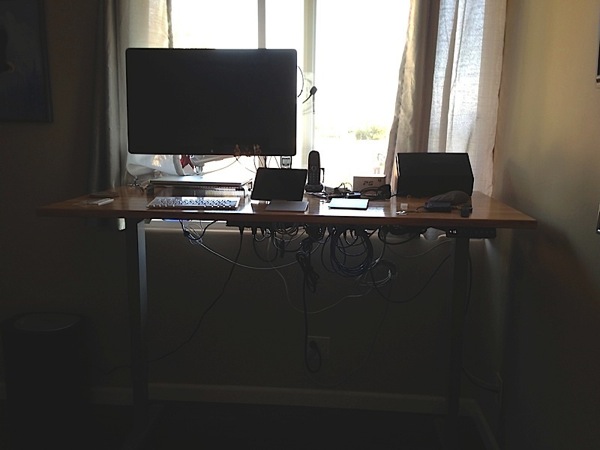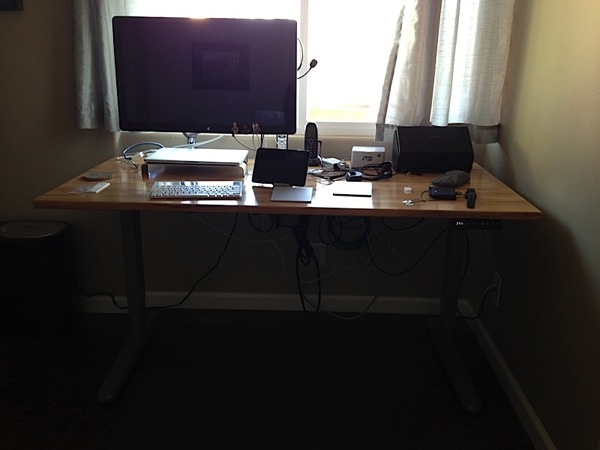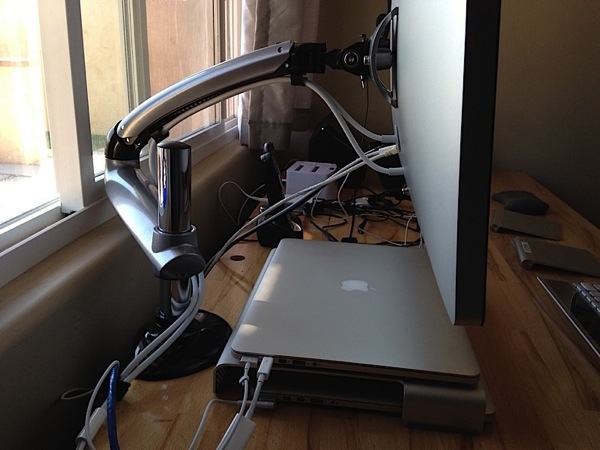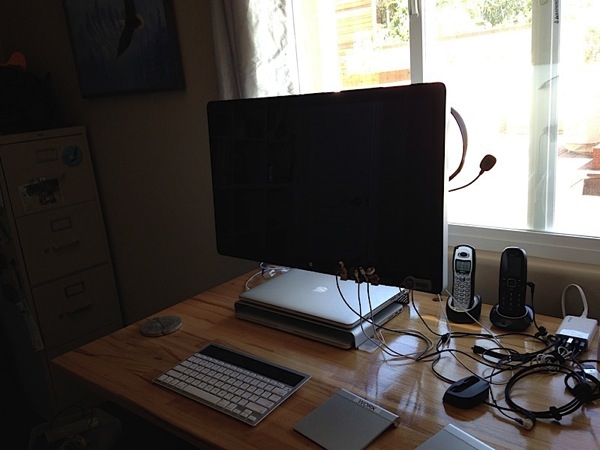-
Review: Logitech K760 Wireless Bluetooth Keyboard
I haven't been a huge fan of Bluetooth keyboards because most of them require you to change batteries periodically and they generally lack a number pad. In May, due to changes at work, I was faced with having 2 computers on my desk. While both computers were MacBook Pros, I didn't want 2 keyboards, 2 trackpads, and didn't have the room to really leave one laptop open all the time. Ideally I wanted a KVM switch, but I was attached to my Apple Bluetooth Trackpad and my Apple Thunderbolt display can't be used with a KVM.
So where did that leave me? I had a second trackpad, so now I had 2 trackpads on my desk. I could easily unplug my Thunderbolt display and plug it into the other computer. I could keep my USB keyboard plugged into the Thunderbolt display and have it go along for the ride when I switched computers, but decided to look at keyboards that would switch between multiple devices. I settled on the Logitech K760
wireless keyboard. The keyboard allows me to pair 3 Bluetooth devices (2 Macs and an iPad), recharges via solar, and resembles a Mac keyboard. The only thing I was giving up was a numeric keypad.
I quickly got used to the lack of a numeric keypad as the MacBook Pro's built in keyboard doesn't have one. Being able to switch between devices is easy and not having a wire was like a light shining down on me that I should have done it sooner! Even moving the keyboard slightly is less of a hassle as the cord isn't coming with it.
In the 3 months that I've had the keyboard, it has been fantastic. I haven't had any problems with it, it feels just like my Apple keyboard did and the addition of an off switch allows me to easily clean it. There isn't a whole lot to say about a keyboard; I type on it and it works.
Pros
- Wireless
- Supports up to 3 Bluetooth devices
- Recharges via solar panels on it
Cons
- No numeric keypad
Summary
If you're looking for a wireless keyboard, this keyboard is definitely worth a look. Not having to change batteries alone could be the deciding factor. The multiple device support may seem like a gimmick, but I find I use it all the time even for my iPad. This keyboard rivals Apple's Bluetooth keyboard, in my opinion.
-
Review: Jarvis desk
I've been reading about how bad sitting is for your health and basically ignored it by saying that I get up enough and I run. Lately there have been even more studies saying that exercise doesn't help the situation. I still wasn't convinced.
A few months ago, my hip starting hurting and it seemed to be worse when I was sitting, so I thought about a standing desk, but the cost made me put it on my list, but postpone the purchase. About 3 weeks ago, I bought some tall legs for my desk from Ikea and put them on; I was extremely excited about this as I would be able to stand all day. Two things I didn't consider with this move. First off, standing for a long time hurts my feet and the second is that my son likes to be at my desk sometimes and with the desk so high, he couldn't sit with me.
So I started researching adjustable height desks. The cost range is huge and I didn't really want to replace my current desk with some several thousand dollar desk. I refinished my desk last summer and put lots of coats of urethane on it; the desk has held up quite well. Several reviews pointed me to the Jarvis Desk
. I looked at the specs and was impressed; the cost was reasonable, it had a motor to raise and lower it, and it had a memory to remember the positions. The final piece that convinced me to make the purchase was that I could order just the frame without the top; this shaved some money off the cost and I got to continue use the desk top that has treated me well for years.
I ordered the frame from Amazon and it arrived in 2 days; the price was the same as direct from the company, so I figured I'd go with the faster shipping. The box was heavy...74 pounds. I managed to get it downstairs into my office and assembled it all in about 45 minutes in between working. It wasn't complicated to assemble, but had a lot of steps. When my wife got home, she helped me flip over my old desk and put the desk frame on my top. Attaching the frame to the top was straightforward and quick with the use of an electric drill.
After flipping over my desk and setting it into place, I plugged it in and raised it up. The speed was pretty amazing. The rated speed is 1.5"/sec unloaded. My standing position is only about 11 inches higher than my sitting position, so it takes less than 10 seconds to change position. I've programmed an up and a down position for it.
The first week I had the desk, I was standing as much as possible. Now that I've had it for a bit, I'm finding that I'm alternating between sitting and standing throughout the day. The change is extremely easy.
I've found that my hip isn't hurting as much (I've combined some stretching with the standing to help) and standing allows me to concentrate more sometimes.
While these pictures aren't great, I've attached an up and a down picture.


Pros
- Affordable
- Quiet mechanism
- Fast
- Appears well built
- Very stable
Cons
- Time consuming to setup
Summary
I should have made this purchase a lot sooner; there should be no price tag on my health. I don't know the quality of the tops that they sell, but the frame was an excellent choice for me. I'm not sure what the more expensive options would have offered me as the concept of the desk is simple; go up and go down. I also picked up an anti-fatigue mat as standing on your feet all day can hurt; I'd definitely recommend a mat to go with this as well.
Some people have commented that a desk with two legs as opposed to the four I had previously make the desk less stable; I haven't found that the case. I have, however, found that my monitor arm makes the screen jiggle a bit when I type. This is minor and is unrelated to the Jarvis Desk.
I don't know the long term reliability of this unit, but I am hopefully that it lasts a long time even with me adjusting it a few times a days.
-
Review: Freedom Arm for iMac
I've been sitting on an exercise ball for two years instead of a chair at my desk and have grown used to it. However, lately my hip has been hurting me, so I decided to look into a standing desk. I wasn't quite sure I wanted to commit to a standing desk, so I started looking at what pieces I could use to test the theory. I was a little too quick on the draw and bought a Freedom Arm for iMac
to allow me to raise my monitor up off my desk. I was expecting it to raise the display high enough that I could stand, but its rise was a maximum of 8" where I needed about 20 inches off the top of my desk.
After I made the "mistake", I realized that having the ability to move my monitor around wherever I wanted would be useful even if I didn't like a standing desk.
I received the arm last Friday and thought installation would be pretty straightforward. I was, of course, wrong. The first tricky part after taking off the stand on my Apple Thunderbolt display was locking the connector (meant for a VESA adapter). You have to use a card to push a lever in the display. This isn't a knock on the monitor arm, but something that was a bit difficult.
After locking the connector, I screwed in the adapter plate that came with the arm into the display. When it came to attaching the arm to the plate, I ran into problems and ended up taking off the plate. Turns out the holes for the screws were messed up and the screws were difficult to turn. I tried my best to screw them in, but wound up snapping the head off one of the screws. So now I had a mess on my hands and really wanted to get the arm setup. I spent a few hours trying to get the screw out and managed to simply cut off the head and drilled out the screw. I was going to have to wait until Monday to contact the company.
I was giving up and had to get the stand on my display back on; this proved to be another problem and I took apart the display to see what I was trying to press to get the locking connector to retract. That was successful and I was back to square one.
Not being content on waiting, I decided to take the adapter plate to Home Depot and see if I could get a tap for the screw and re-tap the hole. A very nice associate helped me figure out the screw size (it was an M6 screw) and found me a tap kit that included a hardened drill bit and the tap. Once I got home, I was able to re-drill the holes and tapped the holes without a problem.
I continued putting the arm together and was done in a relatively short amount of time. After the initial problem, I didn't encounter any other issues with it.
Now that I've been using it for a few days, I'm very pleased with the flexibility of the arm and how sturdy it is. Any type of monitor arm is going to have some wiggle to it when typing, but that is expected due to it being cantilevered.
Even if this doesn't work out for my standing desk, having the arm and being able to position the monitor will be worth it.
Pros
- Sturdy
- Comes with adapter plate for older iMacs and the Thunderbolt display
- Reasonably priced
- Highly adjustable
Cons
- The screw holes in the adapter plate I received weren't tapped well.
Summary
If you have an iMac or a Thunderbolt display and want a little more space on your desk or want to be able to easily position your display, this arm will easily meant your needs. There are other monitor arms out there and if you put a standard VESA mount on the display, your choices grow even more; however, for the cost, the arm is a great value. My only caution is that if you have problems with the screws, stop and contact the company; don't do what I did and cause myself more work.

-
Well meaning law gone awry
Yesterday I was in a shoe store with my family when I bumped into something. I instinctually said "I'm sorry" and then looked to see the person I accidentally bumped. I looked down and saw a dog instead of a person. (I do apologize to my own dog all the time, but was a little surprised to see a dog in a store.)
I'm not sure when people started routinely bringing dogs into stores, but I seem to recall only seeing service dogs with vests or dogs with harnesses to assist blind people coming into stores. My guess is that people have taken a lot of liberties with the Americans with Disability Act and have taken to redefining what is a service dog. The law states that a person in a business, restaurant or other public place may only ask 2 questions to someone bringing in a service dog:
- Is the dog a service animal required because of a disability?
- What work or task has the dog been trained to perform?
They cannot ask the person to provide documentation or otherwise prove that the dog is a service dog. It appears that many businesses don't bother asking because that could open the store up to a lawsuit.
Not only are dogs being brought into stores (Home Depot, Target, Costco, etc.), they are also being brought to farmer's markets. The California law doesn't permit dogs within 20 feet of where food is stored; the farmer's market we've been to in Little Italy has an aisle between the sides of the street of less than 20 feet, I'd say. This would prohibit dogs completely from being at the farmer's market (except for service dogs, of course). However, people bring their dogs to the market and have their dogs come close to the booths where food is being handled. Do you really want dogs going near food that you might purchase? I love dogs, but I really don't want dogs near my food.
While I do see the rationale for not asking for documentation and embarrassing those that are disabled, there must be a way to better handle this than to effectively let everyone bring dogs into stores. California does make it a misdemeanor to misrepresent a service animal (California Penal Code 365.7), but I suspect it is rarely enforced. Can people be taught to be considerate and keep their pets at home? I know that pets are family, but they don't have to go everywhere. Doing some searches on this topic seems like I'm not the only one annoyed by this trend.